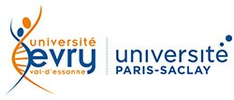

Comparative Genomics Tools
This interface allows the user to define a set of genomes and displays a tree showing the genomic similarity.
The genomic similarity is estimated using Mash, a software that computes a distance between two genomes. This distance is correlated to the ANI like: D ≈ 1-ANI
From all the pairwise distances of the genomes set, a tree is construct dynamically using the neighbor-joining javascript package.
The tree displays clustering annotations. This clustering has been computed from all-pairs distances ≤ 0.06 (≈94% ANI) that correspond to the ANI standard to define a species group.
The clustering has been computed using the Louvain Community Detection.
It allows the users to:
- Compute pan-genome and core-genome sizes and their evolutions for a genome set
- Determine the common and variable genome proportion for each genome
- Exclude the pan, core and variable-genome of another genome set to the analysis
- Extract core-genome, variable-genome and strain specific sequences and annotations.
This page displays macromolecular systems found in the genome.
MacSyFinder v2.1.2 is a program to model and detect macromolecular systems (cellular machinery, metabolic pathways) in protein datasets. In prokaryotes, these systems have often evolutionarily conserved properties: they are made of conserved components, and are encoded in compact loci (conserved genetic architecture). Its detection methods work by searching components of the systems by sequence similarity using Hidden Markov Models (HMM) profils and analyzing the content and organization of the system.
This page displays prophages and defense systems found in the genome.
A prophage is a bacteriophage genome that is integrated within a prokaryote genome. We use Phigaro to detect such regions.
A defense system is a molecular system used to defend the prokaryote against bacteriophages. We use DefenseFinder and CRISPRCasFinder to detect such regions.

 Loading
Data ...
Loading
Data ...







